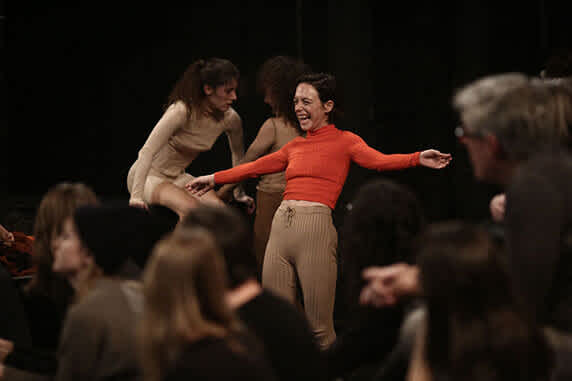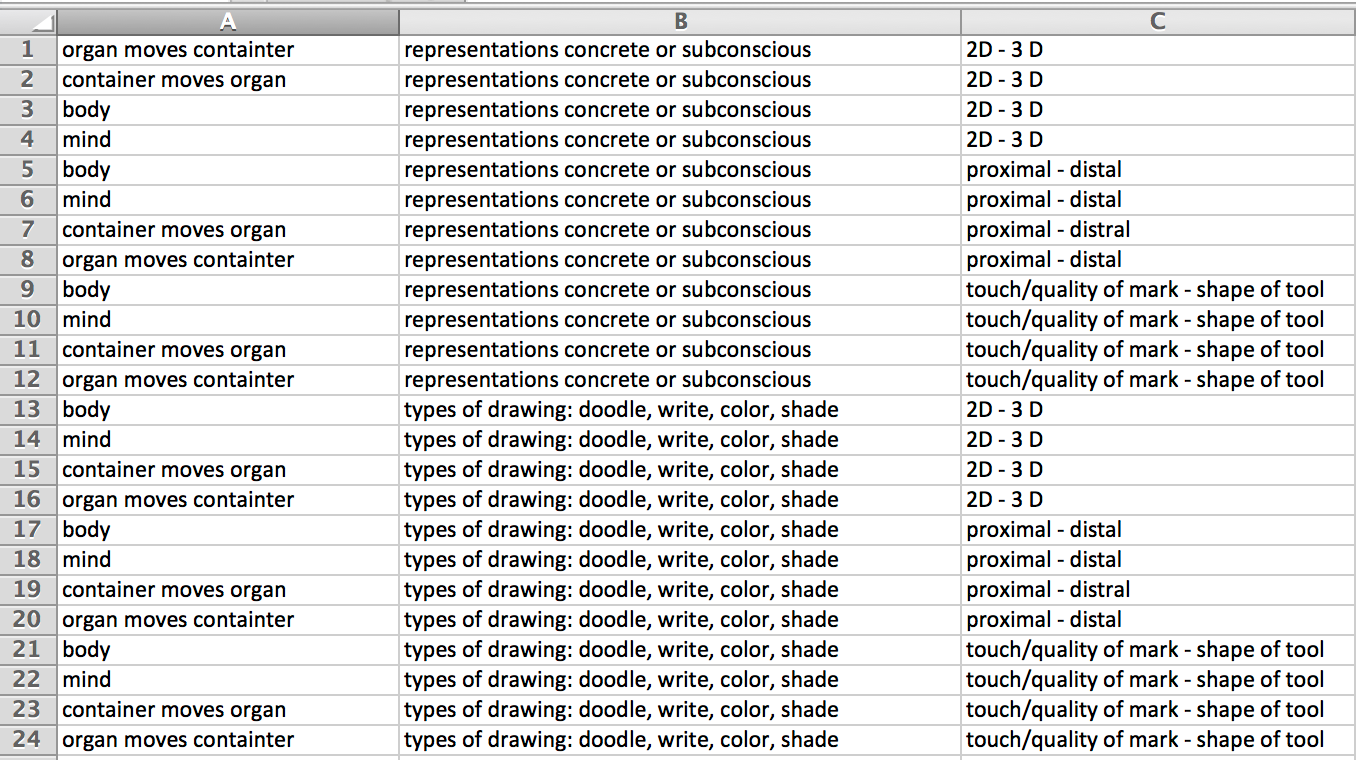
On View: May 29-June 26, 2020
This Video Viewing Room presented two performance recordings of Moriah Evans, Configure (2019) for one month from May 29 through June 26, 2020. The remaining components of this page include still images of the performance, a statement written by the artist, and an excerpt from the score of movement strategies for this piece.


Dear Viewer,
By the time you watch and read this, it is June 2020. I like to consider the numerology of my performance dates. When figuring out dates for a premiere of a work, I ponder the mathematics and the alchemy of the numbers by looking for their internal logic—even if only relevant to me, never noticeable by others. Did something significant happen in the world (or personally) on those dates but in another year? Days are not dates. Time is different right now, which is already a cliché, by now. All because of time.
Time is a medium. Waiting is a message. When will we gather together again, amongst strangers and friends, in flesh, and inside the flesh, and stuff, of a theater? Configure premiered at The Kitchen on December 5–8, 2018 at 8pm. Four performances. Two were recorded. Here are two videos: one from Friday, December 7, 2018 and another from Saturday, December 8, 2018. Credits, context, and collaborators are important, so read it now and again: Configure was performed by myself, Lizzie Feidelson, Nicole Mannarino, Lydia Okrent, and João dos Santos Martins. The work also featured sound design and live performance by Ka Baird, lighting design by Madeline Best, costumes by Strauss Bourque-LaFrance, dramaturgy by Joshua Lubin-Levy, and was curated by Matthew Lyons. $25 tickets.
The choreographic structure of Configure appeared and dissolved nightly, in the presence of the public, in the same way a dance might be said to disappear in the wake of its enactment. Each performance is unique. An action transpires; it can never be repeated again, not in the same way. Dance—forever original, never original. A performance happens once—“you had to be there.” Period. A dance becomes an invisible speculative terrain of rumors—often only about whether people “liked” it or not and not very often analyzed through shared values of critique or care. These videos are translations, a tertiary thing: filmed through the eyes of two different videographers, Iki Nakagawa and Joseph Bacon, unfamiliar with the work and then edited by Iki into what’s here. Do not mistake these videos for the work nor for the performance. Configure calls for a very present spectatorship and a highly volatile level of performativity in which the relation between the public and the performers is intended to be a felt experience, of being with flesh, in the room together. The work intentionally builds off the affect of perception—of being watched (whether by an audience or other dancers in the performance), and of watching over one’s self as performers attempt to perceive, and work from, the internal operations of our biological bodies. Often working at a scale imperceptible to the human eye, together performers and audience build a relation that resides elsewhere than the theater’s dependence on vision. Can the relations with “publics” shift from critique to care in art?
It is quite a challenge to transfer this work to video (and even further to the internet), to the pervasive individualized and fragmented yet communal screen—which of course operates as a means for people to gather around a moving image, displaced in time and space from the performed event. What does this displacement do? How do we all “configure” now that being in a room together is indefinitely suspended? The stage is an opaque and explicit site that turns everyone there into some type of representation, but in a different manner than the screen. The flesh and stuff of our insides and the stuff and flesh of the theater apparatus. Time is a medium; waiting is a message. How to make literal and metaphoric feminist architectures on the stage, a site of display? How can we upset racist, colonial, and patriarchal regimes inscribed into bodies, institutions through dancing, choreographing? How to create a constellar model of meaning-making that relies on reciprocity, mutual inspiration between artists and their publics? How does the use of the theater/dance change if we think of it as a web of practices, a mesh of environments and processes with a socio-political and ecological correspondence? Interrogate the ethics of the environments created in the “how” of processes to dismantle power structures that function as violent, default assumptions. How do we stand in attendance together? How is attending to multiple forces and factors an act of care?
Some descriptive language: Configure continued my research into the choreography of intimate movements. Part exercise in embodiment, part feminist architecture, the work insists on paradigms of interiority, collectivity, materiality, alterity, and performativity. It embraces uncontrollable affective states and inexact vocabularies of flesh. The raw bodies, and raw feelings, exposed are not points of departure, but the (perhaps impossible) points of arrival. How can we unscript our bodies through dance, even against dance, and compulsions to use bodily facility as a vehicle for visual communication and expression? The practice that drives Configure was developed over several years of research (first used in Figuring, which premiered at SculptureCenter, January 2018). We participate in a rigorous exercise of initiating movement from three embodied modes: organ work (modes of vibration, rhythm, drawing, electrocution, and displacement from internal points of origin that can be speculated, imagined or felt, but not seen), expulsion work (tasks of laughing, crying, jumping, and wasting) and reflection work (forms of coaching, question and answering, inscription, and discussion). The dancing activity produces the work’s choreographic structure—individuated mini events configuring towards a collective macro event—through a process of shared decision-making. The work attends to the process of dance’s construction, rather than its form. Every dance is also a study in how to work together as a group. Marxist-feminist Silvia Federici’s calls for a struggle that begins with “the re-appropriation of our body, the revaluation and rediscovery of its capacity for resistance, and expansion and celebration of its powers, individual and collective... From dance we learn that matter is not stupid, it is not blind, it is not mechanical, but has its rhythms, has its language, and it is self-activated and self-organizing.”
I put my life into my dances, my whole being towards the excess of dance and art. Relentless. Overdoing it. What to do when you are not an essential worker? In fact, what do you do when you are most definitely an inessential worker? Get in touch with existing endlessly in a state of raw vulnerability. When I was 22 I believed that vulnerability was power; 18 years later, I am not so sure. During this pandemic, I say yes to change. I have often been resistant about transferring my work to video. I have always been transparent, but I think artists are often told to hold onto their ideas, to protect them, to keep them private, veil them in secrecy, luxury, myth. What is private and hence privatized and what is given to the public is a conundrum—especially when it comes to dance. If you guard something carefully are you protecting it for its sake or your own? In these videos, the performers and the public perform. Try to feel it. Use headphones to pick up a semblance of the sub frequencies, feel the sound. Watch the people watch the dance.
Configure addresses a way in which working from the unseen, yet felt, world of bodies and space might unfold into new social possibilities. This feels apt for now. Harnessing the somatics of abjection as a mechanism to turn insides out, using dance to viscerally interrogate what it means to be or to have a body today—let’s stage bodies in revolt to make a social body and a choreography in search of itself. Bodies are portals to alternative logics, functioning as stages, both explicit and opaque sites. Who controls the unfolding of bodily signifiers? What is deemed appropriate/inappropriate? Every body is socially marked, and yet...
In these times of aimless reflection, we can dance; everyone can dance. We still can dance—together and alone. We can care.
— Moriah Evans

